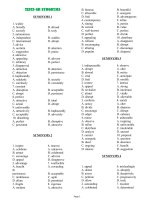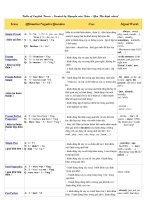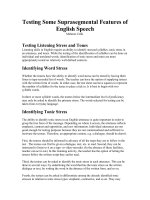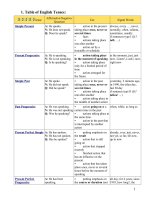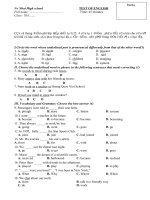ETYMOLOGY OF ENGLISH WORDS
Bạn đang xem bản rút gọn của tài liệu. Xem và tải ngay bản đầy đủ của tài liệu tại đây (155.53 KB, 18 trang )
Nếu có hình trong tệp đính kèm này, hình này sẽ không được hiển thị. Tải
xuống tệp đính kèm gốc
Unit 2:
ETYMOLOGY OF
ENGLISH WORDS
Contents
Translation - Loans
International words
History of the English language
Changes
borrowed words go through
Etymological doublets
Relationship between etymological
and stylistic characteristics
of words
1.
History of the Englis
h language
Are all English words really
English?
1.
History of the Englis
h language
o English belongs to the Indo-
European family of languages.
o E.g.:
o English
vocabulary contains an immense
number of
words of foreign origin.
bhrãter
mãter
Indo-European
Frater
mater
Latin
Bruder
mutteR
German
Brother
mother
English
1.
History of the Englis
h language
• Different
epochs of the development
of English language,
• The first century B.C
• T(e fifth century, A.D
• The seventh century, A.D
• From the end of the 8
th
century
to the middla of the 11
th
century
• 1062
• The Renaissance Period
1.
Histo2y of the Englis
h language
• The
Etymological Structure of
English Vocabulary.
• Celtic (5
th
– 6
th
century A.D)
century A.D)
•
La
Latin
•
1
1
st
group: 1
group: 1
st
c. B.C
c. B.C
•
2
2
nd
group: 7
group: 7
th
c. A.D
c. A.D
•
3
3
rd
group: the Renaissance period
group: the Renaissance period
•
Scandinavian (8
Scandinavian (8
th
-11
-11
th
c. A.D)
c. A.D)
•
French
French
•
Norman borrowings: 11
Norman borrowings: 11
th
–
13
13
th
c. A.D)
c. A.D)
•
Parisian borrowings (Renaissance)
Parisian borrowings (Renaissance)
•
Greek (Renaissance)
Greek (Renaissance)
•
Italian (Renaissance and later)
Italian (Renaissance and later)
•
Spanish (Renaissance and later)
Spanish (Renaissance and later)
•
German
German
•
Indian
Indian
•
Russian
Russian
And some other groups
And some other groups
•
Indo-European
Indo-European
element
element
•
Germanic element
Germanic element
•
English Proper element (not earlier
English Proper element (not earlier
than 5
than 5
th
century A.D)
century A.D)
The borrowed element
The native element
The native element
• The
native element in English compri
ses a large number of high-
frequency words like
the articles, prepositions, prono
uns, conjunctions,
auxiliaries, and, also, words de
moting everyday
objects and ideas.
• The grammatical structure is
essentially Germanic having
remained unaffected by foreign
influence.
2. Changes borrowed words go
through
Do borrowed words change
or do they remain the same?
2. Changes borrowed words
go through
• Borrowed
words adjust themselves to thei
r new environment
and get adapted to the norms of
the recipient language.
• They are adjusted in the 3 main
areas of the new language
system
• The phonetic
• The grammatical (consists in a
complete change of the former
paradigm of the borrowed
word).
• The semantic (means
adjustment to the system of
meaning of the vocabulary).
3. International
words
• A word
is borrowed by several language
s, and
not just by one. Such words usu
ally
convey notions which are signifi
cant in
the field of communication.
• E.g.:
• Names of sciences: philosophy,
mathematics, physics,
lexicology, etc.
• Terms of arts: music, theater,
drama, artist, etc.
• Political terms: antibiotic, radio,
sputnik, etc.
• Sport terms: football, volleyball,
hockey, golf, etc.
• Fruits and foodstuffs: coffee,
chocolate, etc.
4.
Etymological doublet
s
• Etymology doublets are words
originating from the same
etymological source, but
differing, to some extent, in
phonemic shape and in
meaning.
• Some of these pairs consist of a
native word and a borrowed
word
• E.g.: shirt (E) – skirt (Sc),
shrew (E) – screw (Sc)
• Others are represented by two
borrowings from the same
language twice, but in different
period.
• E.g.: travel (Norm. Fr) – travail
(Par. Fr)
• A doublet may also consist of a
shortened word and the one
form which it was derived.
• E.g.: history – story
fantasy – fancy - fan
4.
Etymological doublet
s
• Etymological triplets (i.e.
groups of words of common
root) occur rarer.
• E.g.:
• hospital (Lat.) – hostel (Nor.) –
hotel (Par.)
• to capture (Lat)- to catch (Nor.
Fr)- to chase (Par. Fr)
5.
Translation - Loans
• Translation – Loans are
borrowings taken into the
vocabulary of another language
under the process of translation.
• Only compound words (i.e.
words of two or more stems)
can be subjected to such an
operation, each stem being
translated separately
• E.g.:
• masterpiece (from Germ.
Meisterstuck)
• Wonder child (from Germ.
Wunderkind)
6. Relationship between
etymological and stylistic
characteristics of words
• The
center of gravity of borrowed wo
rds in
the stylistic classification is repr
esented
by two groups: learned words a
nd terminology.
• The whole opposition of “formal
versus informal” is based on the
deeper underlying opposition of
“borrowed versus native”, as the
informal strata, especially slang
and dialect, abound in native
words.
• Comparing the expressive and
stylistic value of the French and
the English words in such
synonymic pairs, the French
words are more formal, more
refined, and has less strong hold
on the emotional side of life.
• E.g.:
• To begin – to commence
• To wish – to desire
6. Relationship between
etymological and stylistic
characteristics of words
• Compare
some pairs which consist of a na
tive wnrd and a Latin synonym.
Infantile (dry)
e.g. infaNtale disease
Childish
(wonder and
vivid poetry of the %arliest human
age)
e.g.: childish charm
Maternal feelings
(sounds dutiful but cold)
Motherly love
(snunds warmer)
Exercise 1: Supply the
adjectives of Latin origin correspon
ding to the following nouns.
Nose
Hand
Sea
Egg
Tooth
Child
Life
Sun
Town
Youth
Dog
Cow
Bird
Home
Water
Mouth
Body
Countryside
Ear
Year
Eye
Star
Earth
Sight
Side
Exercise 1: Supply the
adjectives of Latin origin correspon
ding to the following nouns.
Nose - nasal
Hand - manual
Sea - marine
Egg -oval
Tooth - dental
Child - infantile
Life - vital
Sun - solar
Town - urban
Youth - juvenile
Dog - canine
Cow - bovine
Bird -
Home - domestic
Water - aquatic
Mouth - oral
Body - corporal
Countryside - rural
Ear - aural
Year - annual
Eye - optical
Star - astral
Earth - terrestrial
Sight – visual
Side - lateral
Thank You !


